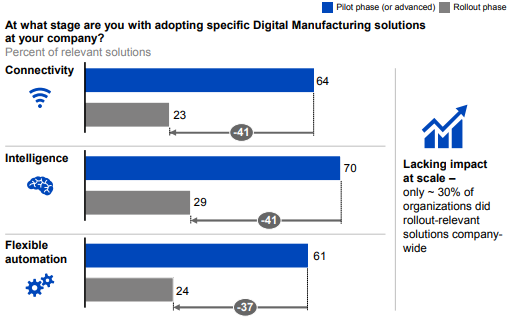The World Economic Forum (WEF) Initiative on Shaping the Future of Production is collaborating with McKinsey & Company, a New York-based management consulting firm, to find manufacturers successfully implementing new technologies, i.e., the 4IR “[Fourth Industrial Revolution] production lighthouses.”
According to McKinsey, the Fourth Industrial Revolution(Industry 4.0) is expected to create up to $3.7 trillion in value by 2025. Thus, the initiative’s long-term goal is to develop an international learning platform for manufacturers seeking to leverage internet of things (IoT), advanced robotics, artificial intelligence (AI), additive manufacturing and other digital processes.

With nine lighthouse candidates currently identified, I speak with Enno de Boer, Partner, and Global Leader of Manufacturing at McKinsey & Company, USA, about the challenges, trends, and innovations surrounding the adoption of technologies within the additive manufacturing sector.
Increasing worldwide productivity
Commencing in 2016, the WEF initiative’s community has accumulated experienced organizations such as McKinsey, reaching 26 countries and 18 industry sectors. This network continues to grow as the initiative pursues those innovation that boost economic growth. According to McKinsey, the presence of Industry 4.0 comes after a decade of stagnated productivity.
Within this initiative, the companies are exploring how manufacturers are adopting new technologies from proof of concept to the industrial scale, with the intention of streamlining production processes. As seen through recent findings, McKinsey has recognized the challenge of pilot purgatory – where companies trialing digital manufacturing technologies are unable to successfully roll them out at scale.
According to De Boer, “the three biggest reasons for pilot purgatory are lack of resources/knowledge to scale, high cost of scaling, and difficulty in justifying the business case without short-term impact.”

The smart factory lighthouse candidates
Nevertheless, as a result of an ongoing search, nine lighthouses who have successfully deployed such technologies while “keeping humans and sustainability at the heart of innovation” have been identified.
Three of the lighthouses operate in China. Bosch Automotive, that has integrated advanced data analytics to eliminate its output losses. Consumer electronics company Haier that developed an AI supported, intelligent service cloud platform to predict maintenance needs. And Siemens Industrial Automation Products that developed a fully integrated software platform capable of taking customer orders and immediately allocating resources and schedule production time.
From Europe there is Bayer, Division Pharmaceuticals, Johnson & Johnson’s DePuy Synthes, and Phoenix Contract, all of which have integrated the digital twin concept to cost-effectively secure physical assets within production. In addition, Schneider Electric and Procter & Gamble’s Czech subsidiary have enabled “end-to-end synchronization” of supply chains due to integrated web-based analytical models.
Finally from the U.S. is Fast Radius. The Chicago-based company continues to use 3D printing to meet the increasing demand for products requiring a fast turnaround and mass customization. Its technologies include an industrial-grade 3D printing and a proprietary operating system that enables “real-time analytics and orchestrates design, production, and global fulfillment.”
“Additive manufacturing is a long-term game changer and that adoption can continue as manufacturers move beyond prototyping and truly understand what it means for broader production,” explained De Boer.
“There is room for continued adoption of this technology as new business models – such as on-demand and distributed manufacturing – continue to evolve as well as in response to the traditional business model where 3D printing can help existing businesses reduce inventory, and streamline operations.”
The 4IR global learning platform
With ongoing searches for more lighthouse candidates, De Boer stated, “The learning platform will continue to grow and evolve much like the Fourth Industrial Revolution and its technology. There will always be new lighthouses emerging, new applications of technology and new transformational change stories. A global learning platform needs to be agile and think of itself as constantly evolving – never as a “finished product” – if its aim is to be relevant and useful.”
The first version of the platform, hosted by WEF is set to go live in the near future. De Boer adds, “Additionally, the WEF will facilitate first visits of lighthouse factories starting in the end of 2018, allowing senior executives from public and private organizations to learn and build new collaborations.”
The first full class of 2018 lighthouses will be announced at the WEF’s Annual Meeting in Davos, Switzerland in January 2019, however, searches will continue throughout 2019.
Follow this project and keep up with the latest 3D printing news by subscribing to the 3D Printing Industry newsletter. Also, follow us on Twitter, and like us on Facebook.
Searching for new talent or seeking a career change? Search and post 3D Printing Jobs for opportunities and new talent across engineering, marketing, sales and more.
Featured image shows the digitization of manufacturing processes. Image via Mckinsey & Company.


